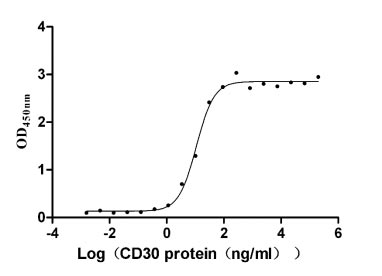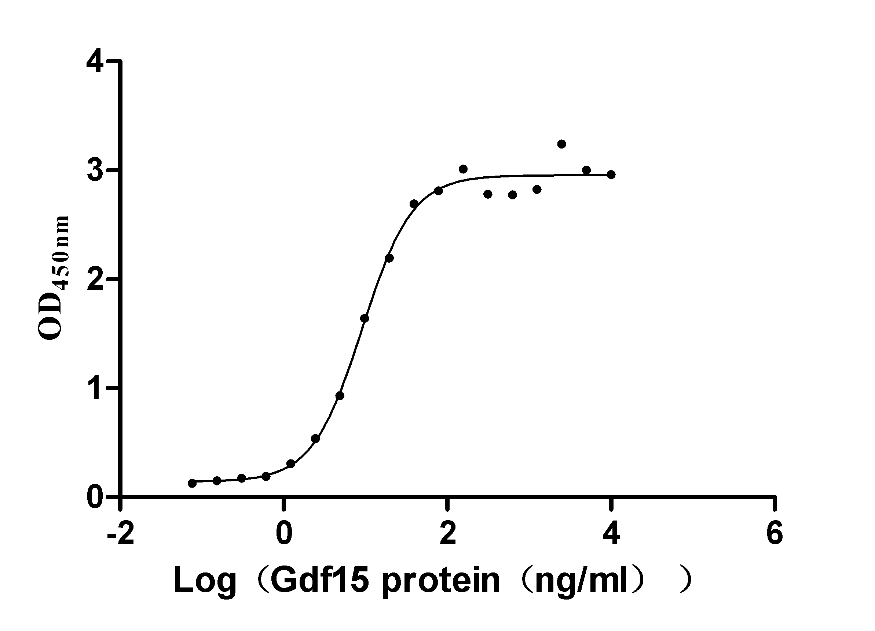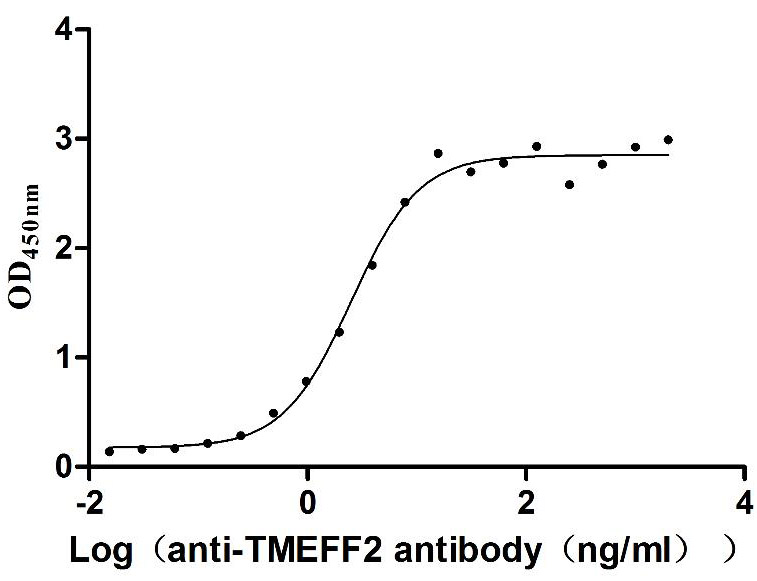Recombinant Human Dihydropyrimidinase-related protein 3 (DPYSL3)
-
货号:CSB-YP622756HU
-
规格:
-
来源:Yeast
-
其他:
-
货号:CSB-EP622756HU
-
规格:
-
来源:E.coli
-
其他:
-
货号:CSB-EP622756HU-B
-
规格:
-
来源:E.coli
-
共轭:Avi-tag Biotinylated
E. coli biotin ligase (BirA) is highly specific in covalently attaching biotin to the 15 amino acid AviTag peptide. This recombinant protein was biotinylated in vivo by AviTag-BirA technology, which method is BriA catalyzes amide linkage between the biotin and the specific lysine of the AviTag.
-
其他:
-
货号:CSB-BP622756HU
-
规格:
-
来源:Baculovirus
-
其他:
-
货号:CSB-MP622756HU
-
规格:
-
来源:Mammalian cell
-
其他:
产品详情
-
纯度:>85% (SDS-PAGE)
-
基因名:DPYSL3
-
Uniprot No.:
-
别名:Collapsin response mediator protein 4; Collapsin response mediator protein 4 long; CRMP 4; CRMP-4; CRMP4; Dihydropyrimidinase like 3; Dihydropyrimidinase related protein 3; Dihydropyrimidinase-related protein 3; DPYL3_HUMAN; DPYSL3; DRP 3; DRP-3; DRP3; LCRMP; TUC4; ULIP 1; ULIP; ULIP-1; ULIP1; UNc 33 like phosphoprotein 1; Unc 33 like phosphoprotein; Unc-33-like phosphoprotein 1
-
种属:Homo sapiens (Human)
-
蛋白长度:full length protein
-
表达区域:1-570
-
氨基酸序列MSYQGKKNIP RITSDRLLIK GGRIVNDDQS FYADIYMEDG LIKQIGDNLI VPGGVKTIEA NGKMVIPGGI DVHTHFQMPY KGMTTVDDFF QGTKAALAGG TTMIIDHVVP EPESSLTEAY EKWREWADGK SCCDYALHVD ITHWNDSVKQ EVQNLIKDKG VNSFMVYMAY KDLYQVSNTE LYEIFTCLGE LGAIAQVHAE NGDIIAQEQT RMLEMGITGP EGHVLSRPEE LEAEAVFRAI TIASQTNCPL YVTKVMSKSA ADLISQARKK GNVVFGEPIT ASLGIDGTHY WSKNWAKAAA FVTSPPLSPD PTTPDYINSL LASGDLQLSG SAHCTFSTAQ KAIGKDNFTA IPEGTNGVEE RMSVIWDKAV ATGKMDENQF VAVTSTNAAK IFNLYPRKGR ISVGSDSDLV IWDPDAVKIV SAKNHQSAAE YNIFEGMELR GAPLVVICQG KIMLEDGNLH VTQGAGRFIP CSPFSDYVYK RIKARRKMAD LHAVPRGMYD GPVFDLTTTP KGGTPAGSAR GSPTRPNPPV RNLHQSGFSL SGTQVDEGVR SASKRIVAPP GGRSNITSLS
-
蛋白标签:Tag type will be determined during the manufacturing process.
The tag type will be determined during production process. If you have specified tag type, please tell us and we will develop the specified tag preferentially. -
产品提供形式:Lyophilized powder
Note: We will preferentially ship the format that we have in stock, however, if you have any special requirement for the format, please remark your requirement when placing the order, we will prepare according to your demand. -
复溶:We recommend that this vial be briefly centrifuged prior to opening to bring the contents to the bottom. Please reconstitute protein in deionized sterile water to a concentration of 0.1-1.0 mg/mL.We recommend to add 5-50% of glycerol (final concentration) and aliquot for long-term storage at -20℃/-80℃. Our default final concentration of glycerol is 50%. Customers could use it as reference.
-
储存条件:Store at -20°C/-80°C upon receipt, aliquoting is necessary for mutiple use. Avoid repeated freeze-thaw cycles.
-
保质期:The shelf life is related to many factors, storage state, buffer ingredients, storage temperature and the stability of the protein itself.
Generally, the shelf life of liquid form is 6 months at -20°C/-80°C. The shelf life of lyophilized form is 12 months at -20°C/-80°C. -
货期:Delivery time may differ from different purchasing way or location, please kindly consult your local distributors for specific delivery time.Note: All of our proteins are default shipped with normal blue ice packs, if you request to ship with dry ice, please communicate with us in advance and extra fees will be charged.
-
注意事项:Repeated freezing and thawing is not recommended. Store working aliquots at 4°C for up to one week.
-
Datasheet :Please contact us to get it.
相关产品
问答及客户评论
I was hoping for a buffer without glycerol, or for them to be lyophilized. Do you know if these proteins can be provided in the Tris-based buffer without glycerol, or would you recommend they be lyophilized?
Glycerol has a protective effect on proteins. First, it can increase the stability of the protein (reducing the polarity of the buffer and preventing hydrophobic aggregation of the protein).
Second, it can reduce the freezing point of the system and facilitate the preservation of the protein at low temperatures, especially when the protein is repeatedly frozen and thawed.
protein damage (aggregation or inactivation) can be avoided as much as possible. As for the final concentration of glycerol, in principle, the final concentration of 5% -50% has no problem,
it may involve in the preservation of time, high glycerol content is relatively conducive to longer storage. However, the fianl content can be adjusted according to the customer's request,
If the customer insists not to add any glycerol, we can also meet your demand, but we should disclaim in advance that without addition of glycerol may lead to protein instability, especially the protein itself is unstable.
For lyophilized protein: There isn't any glycerol added before or after the lyophilization.
Therefore we recommend that customer can choose lyophilized protein if he has strict requirement on the glycerol.
靶点详情
-
功能:Necessary for signaling by class 3 semaphorins and subsequent remodeling of the cytoskeleton. Plays a role in axon guidance, neuronal growth cone collapse and cell migration.
-
基因功能参考文献:
- Data indicate that CRMP4a and CRMP4b isoforms have opposite effects on cell proliferation, migration, and invasion in gastric cancer. CRMP4a expression was reduced in gastric carcinoma tissues and cell lines and seems to act as a tumor suppressor in gastric carcinoma. CRMP4b expression was higher in tumor tissue and cell lines. PMID: 27475326
- DPYSL3 expression levels inversely correlated with those of VEGF and FAK. Down-regulation of DPYSL3 expression in HCC tissues may serve as a predictive biomarker for HCC after curative resection. PMID: 25173447
- Expression status of DPYSL3 in gastric cancer tissues may represent a promising biomarker for the malignant behavior of GC. PMID: 25096402
- DPYSL3 as pancreatic ductal adenocarcinoma-associated molecule that regulates cell adhesion and migration by stabilization of focal adhesion complex PMID: 24339867
- structures provide further insight into the effects of medically relevant mutations of the DPYSL-3 gene encoding CRMP-4 and the putative enzymatic activities of CRMPs PMID: 24914979
- High collapsin response mediator protein 4 expression is associated with liver metastasis in pancreatic cancer. PMID: 22805864
- Downregulation of MYCN by small interfering RNA (siRNA) increased DPYSL3 levels, while upregulation of MYCN in non-MYCN NB cells decreased DPYSL3 levels. PMID: 24011394
- study found the association between the rs147541241 variant and amyotrophic lateral scerosis was limited to the French population PMID: 23568759
- Ulip1 was downregulated and HIF1a was upregulated in hypoxic neuroblastoma cells. PMID: 20977846
- CRMP4 is a key physiological substrate of GSK3 in regulating chromosomal alignment and mitotic progression through its effect on spindle microtubules PMID: 21179545
- Data show that two genes, LTB4DH and DPYSL3, were confirmed to be candidate genes for the predictor of a good immune response. PMID: 20804502
- new function of CRMP4 as a metastasis-suppressor in lymph node metastasis of prostate cancer PMID: 20543870
- HUlip was expressed in late fetal and early postnatal brains in the neurons of the brain stem, basal ganglia/thalamus, and dentate gyrus of the hippocampus. HUlip expression was easily detected in tumor cells undergoing neuronal differentiation. [Ulip] PMID: 15933812
显示更多
收起更多
-
亚细胞定位:Cytoplasm. Cell projection, growth cone.
-
蛋白家族:Metallo-dependent hydrolases superfamily, Hydantoinase/dihydropyrimidinase family
-
组织特异性:Mainly expressed in heart and skeletal muscle. Also strongly expressed in fetal brain and spinal cord.
-
数据库链接:
HGNC: 3015
OMIM: 601168
KEGG: hsa:1809
STRING: 9606.ENSP00000343690
UniGene: Hs.519659
Most popular with customers
-
Recombinant Human Tumor necrosis factor receptor superfamily member 1B (TNFRSF1B), partial (Active)
Express system: Mammalian cell
Species: Homo sapiens (Human)
-
Recombinant Human Tumor necrosis factor ligand superfamily member 8 (TNFSF8), partial (Active)
Express system: Mammalian cell
Species: Homo sapiens (Human)
-
Recombinant Human Tumor necrosis factor ligand superfamily member 8 (TNFSF8), partial (Active)
Express system: Mammalian cell
Species: Homo sapiens (Human)
-
Recombinant Mouse GDNF family receptor alpha-like (Gfral), partial (Active)
Express system: Mammalian cell
Species: Mus musculus (Mouse)
-
Recombinant Human Tomoregulin-2 (TMEFF2), partial (Active)
Express system: Mammalian cell
Species: Homo sapiens (Human)
-
Recombinant Human Tumor-associated calcium signal transducer 2 (TACSTD2), partial (Active)
Express system: Mammalian cell
Species: Homo sapiens (Human)
-
Recombinant Human Alkaline phosphatase, germ cell type (ALPG) (Active)
Express system: Mammalian cell
Species: Homo sapiens (Human)
-
Recombinant Mouse Cytotoxic and regulatory T-cell molecule (Crtam), partial (Active)
Express system: Mammalian cell
Species: Mus musculus (Mouse)




















